Solutions for Electrical Contractors eTool
Installation and Repair » Pulling and Feeding Wire

Electrical employees run or pull wire throughout a worksite. This involves pulling at one end of the run and feeding at the other. Wire is pulled through chases, conduit, or knockouts to get from the electrical supply to the final destination. This path is usually under the floor or in the ceiling, which forces employees to reach up or bend down. When these tasks are performed manually, they often require employees to exert significant force, assume awkward postures, perform repetitive motions, and be exposed to vibration and contact stress.
Potential Hazards
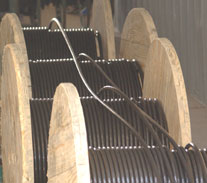
Heavy spools.

Large mechanical wire puller.
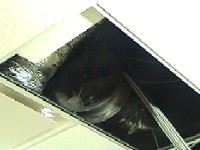
Portable pulley in an open ceiling panel.
-
Due to increased weight and stiffness, pulling larger gauge wire requires greater effort than pulling smaller gauge. This increased effort can stress the hands, arms, shoulders, and back.
-
Running wire through small diameter conduit increases the contact points between the conduit and wire. This increases the resistance, requiring employees to exert more force while pulling.
-
Unwinding wire from spools may be strenuous when wire spools are large and heavy (Figure 1).
-
Pulling wire through bends in conduit creates restriction points, which increases the force required to perform the task.
-
Running wire while standing on ladders results in twisting torso and awkward posture of the upper extremities.
Possible Solutions
-
Use a mechanical wire puller (Figure 2). Pullers provide the force of several employees, eliminating the manual effort needed to pull therefore increasing productivity and reducing risk of overexertion.
-
Appropriately positioned portable pulleys (Figure 3) allow employees to exert larger forces when in proper postures. Employees standing on the ground or other stable surfaces and working with the elbows close to the body and the torso upright can increase effectiveness of the task.
-
Use spool rollers (Figure 4) that allow spools to rotate in place and release wire smoothly without twisting.
-
Install inspection boxes at appropriate intervals so that employees do not have to pull wire through repeated bends or long lengths of conduit.
-
Employees should be provided with platforms, scaffolds, or lifts so that they can raise themselves to do pulling tasks within easy reach and minimize overhead or low-location pulls. Pulling should be done in the power zone.
-
When manual pulling is required:
- take regular breaks from manual pulling, allowing muscles to rest.
- rotate employees between pulling and feeding, installation and repair tasks.
- use gloves that improve coupling and protect the hands from contact stress and cuts.
-
Lubricate wire as it enters chases, conduits or knockouts to reduce friction and force requirement of pulling task.
-
Use platform ladders which provide a work surface where employees may stand and turn to face the direction of work when pulling. This allows employees to exert force in ergonomically correct postures improving efficiency and reduces fatigue. A regular ladder is generally not as desirable since it restricts repositioning, forcing employees to reach and twist the torso when performing pulling tasks.
Potential Hazards
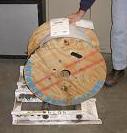
Spool roller.
-
Manually pulling or feeding wire through long runs of conduit may take a great deal of time, requiring highly repetitive forceful exertions involving muscles of the hands, arms and back.
Possible Solutions
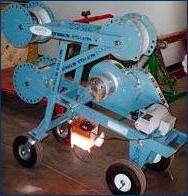
Mechanical wire puller.
-
Use spool rollers (Figure 4) that allow spools to rotate in place, releasing wire smoothly with less effort thus reducing force requirement of the task.
- Use a mechanical wire puller (Figure 5). This can reduce force requirements of the task, thereby reducing the risk and preventing cumulative trauma disorders in the workplace.
- When manual pulling is required:
-
rotate employees between pulling and feeding and installation and repair tasks.
-
use gloves that improve coupling and protect the hands from contact stress and cuts.
-
Potential Hazards
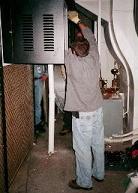
Overhead reaching.
-
Working on overhead tasks in awkward posture with the hands raised above the shoulder may restrict blood flow and result in nerve compression that affects the upper extremities and shoulders causing numbness, tingling, discomfort and fatigue when these postures are maintained for long periods of time. Common overhead tasks may include attaching parts, completing circuits, and pulling or feeding wire. (Figure 6)
-
Awkward postures while pulling with the hands above the shoulder cause an increased load imposed on the shoulders, neck and back. When performed repeatedly, these tasks may result in overexertion of the back and upper extremities.
Possible Solutions
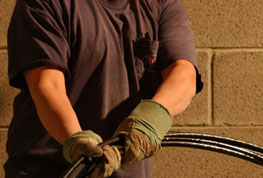
Pulling in the power zone.
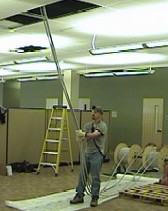
Using a pulley in the ceiling overhead allows employees to pull or guide wire without overhead arm positions.
-
Conduct pre-planning to ensure that employees are provided with appropriate height ladders.
-
Use platform ladders, lifts or other devices to get closer to the work area. Remove impediments such as work tables, bins or power equipment to improve access.
-
Adjust height of the work pieces to allow elbows to stay close to the body within the power zone (Figure 7).
- Use of a portable pulley (Figure 8) combined with mechanical pullers may significantly reduce overhead reaches and force requirements of the task.

